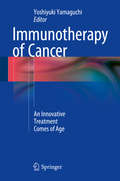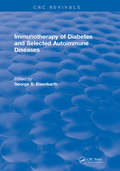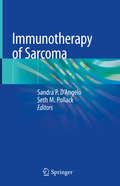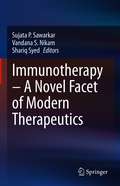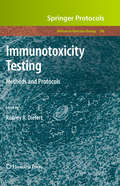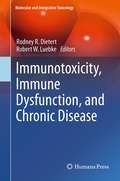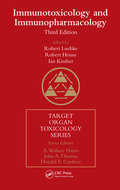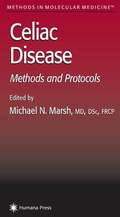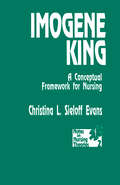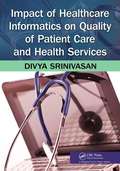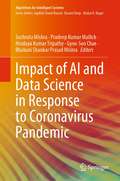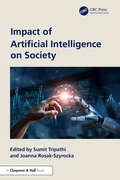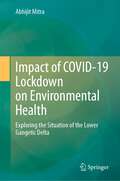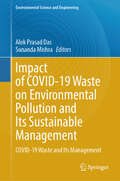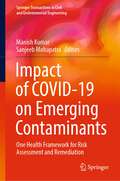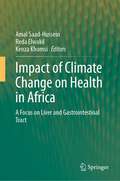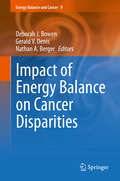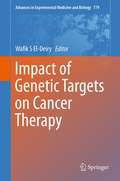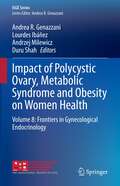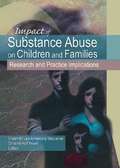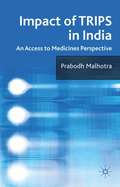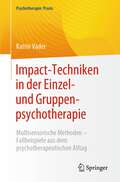- Table View
- List View
Immunotherapy of Cancer
by Yoshiyuki YamaguchiThis timely book, published just as cancer immunotherapy comes of age, summarizes the rationale, present status, and future perspective for cancer immunotherapy. Included are explanations of the constitution of the immune system and immunocheckpoints, the mechanism of antigen presentation and recognition, valuable modalities, clinical trials and guidance, personalization, and biomarkers, all of which are essential for understanding the success of cancer immunotherapy. This innovative therapy has been investigated worldwide as the fourth line of cancer treatment after the standard treatments of surgery, chemotherapy, and radiotherapy. The progress in fundamental understanding of tumor immunology and the recent advances in clinical trials have opened new avenues with a cancer vaccine in 2010 and immunocheckpoint modulation in 2011, with their approval already granted in the United States. Today, there are no doubts, even among experts in cancer chemotherapy and radiotherapy, that the immune system plays a vital role in tumor eradication. Following American approval, many clinical trials of cancer immunotherapy are being conducted. With this book the reader will readily understand the paradigm shift in cancer treatment and will realize the importance of cancer immunotherapy. The great value of immunotherapy will be obvious, not only for tumor shrinkage but for prolonging patient survival.
Immunotherapy of Diabetes and Selected Autoimmune Diseases: Autoimmune 8
by George S. EisenbarthThis important text will be the first devoted to a detailed analysis of immunotherapy as it applies to Type I diabetes and the pathogenesis and therapy of other specific autoimmune diseases (including uveitis, multiple sclerosis, myasthenia gravis, Cogan's syndrome, Graves' ophthalmopathy, and gonadal disorders).
Immunotherapy of Hepatocellular Carcinoma
by Tim F. GretenIn this book we provide insights into liver – cancer and immunology. Experts in the field provide an overview over fundamental immunological questions in liver cancer and tumorimmunology, which form the base for immune based approaches in HCC, which gain increasing interest in the community due to first promising results obtained in early clinical trials. Hepatocellular carcinoma (HCC) is the third most common cause of cancer related death in the United States. Treatment options are limited. Viral hepatitis is one of the major risk factors for HCC, which represents a typical “inflammation-induced” cancer.Immune-based treatment approaches have revolutionized oncology in recent years. Various treatment strategies have received FDA approval including dendritic cell vaccination, for prostate cancer as well as immune checkpoint inhibition targeting the CTLA4 or the PD1/PDL1 axis in melanoma, lung, and kidney cancer. Additionally, cell based therapies (adoptive T cell therapy, CAR T cells and TCR transduced T cells) have demonstrated significant efficacy in patients with B cell malignancies and melanoma. Immune checkpoint inhibitors in particular have generated enormous excitement across the entire field of oncology, providing a significant benefit to a minority of patients.
Immunotherapy of Melanoma
by Anand Rotte Madhuri BhandaruMetastatic melanoma are introduced to the readers, giving details of the diagnosis, clinical symptoms, types and AJCC staging, followed by a discussion of problems in the treatment of melanoma and how immunotherapy provided the solution. Next an account of the immune system is given, describing its role in cancer prevention and discussing how immune check points are circumvented in cancer. Approved drugs are discussed together with their molecular mechanisms of action, response rates, survival benefits, pharmacokinetics and adverse effects. Finally this book discusses the most promising candidates from ongoing clinical trials and highlights challenges faced by immunotherapeutic drugs as well as strategies to overcome them. Metastatic melanoma is a deadly type of skin cancer, known for its resistance to conventional treatments. For decades, patients were managed with a handful of drugs that had minimal survival benefits. The scenario changed with the approval of inhibitors of BrafV600E and MEK, and monoclonal antibodies against CTLA4. While the kinase inhibitors were promising in the initial studies, they suffered with the development of lethal resistance. Anti-CTLA4 monoclonal antibodies (Ipilimumab) on the other hand provided long term survival benefits in responding patients and there were no reports of resistance. However, response rate for Ipilimumab was very low. Recently, monoclonal antibodies against PD-1 receptors (Nivolumab, Pembrolizumab) were approved by FDA for the treatment of melanoma, extending the hope for melanoma patients. This book provides detailed information on immunotherapeutic drugs for melanoma management - it describes melanoma, discusses issues in melanoma treatment and highlights the successes of immunotherapy in the treatment.
Immunotherapy of Sarcoma
by Seth M. Pollack Sandra P. D'AngeloThis book describes recent progress in the development of immunotherapies for advanced sarcoma, paying special attention to the potential role of manipulations of the sarcoma tumor immune microenvironment in improving patient outcomes. Readers will find a thorough overview of the state of the art in tumor immunology and immunotherapy as they relate to sarcoma. Among the topics addressed are advances in vaccine therapy; cytokine therapies; natural killer cells; the development of adoptive T cell strategies; and the scope for use of checkpoint inhibitors in patients with sarcoma, mirroring the tremendous breakthroughs made in other malignancies. Detailed information is provided on laboratory and clinical research, with analysis of outcomes of recent trials and identification of key challenges. There is every reason to believe that more effective and less toxic therapies for metastatic sarcoma can be attained by deepening our understanding of cancer immunology and building on the advances in immunotherapy for other solid tumors. In this context, Immunotherapy of Sarcoma will be of high interest for all medical oncologists responsible for the treatment of sarcoma patients.
Immunotherapy – A Novel Facet of Modern Therapeutics
by Sujata P. Sawarkar Vandana S. Nikam Shariq SyedThis book illustrates the significance and relevance of immunotherapy in modern-day therapeutics. Focusing on the application of immunotherapy in oncology, neurodegenerative and autoimmune diseases, it discusses the drug delivery systems, and pre-clinical and clinical methodologies for immunotherapy-based drugs. It also comprehensively reviews various aspects of immunotherapy, such as regulatory affairs, quality control, safety, and pharmacovigilance. Further, the book discusses the in vitro validation of therapeutic strategies prior to patient application and management of immunotherapy-related side effects and presents case studies demonstrating the design and development (pre-clinical to clinical) of immunotherapy for various diseases. It also describes various design considerations and the scale-up synthesis of immunotherapeutics and screening methods. Lastly, it explores the important aspect of cost-effectiveness and rational immunotherapy strategies.
Immunotoxicity Testing
by Rodney R. DietertRecent critical advances in the field of immunotoxicology have led to incredible contributions to basic science, including crucial improvements in human risk assessment. In Immunotoxicity Testing: Methods and Protocols, expert researchers explore these changes, providing the reader with current, lab-ready procedures, along with the corresponding background information that is necessary to identify effective testing approaches for chemicals and drugs. Among the first volumes to meld consideration of immunotoxicity testing strategies with a comprehensive presentation of detailed laboratory protocols, chapters include a description of the evolution of immunotoxicity testing, a look at the importance of immunotoxicity testing for health risk reduction, and ideas concerning the future of the field. Composed in the highly successful Methods in Molecular Biology(tm) series format, most chapters contain a brief introduction, step-by-step methods, a list of necessary materials, and a Notes section which shares tips from the experts on troubleshooting and avoiding known pitfalls. Comprehensive and innovative, Immunotoxicity Testing: Methods and Protocols is a critical, one-stop reference resource for the most important and commonly used laboratory protocols in immunotoxicology.
Immunotoxicity Testing: Methods and Protocols (Methods in Molecular Biology #1803)
by Jamie C. DeWitt Cheryl E. Rockwell Christal C. BowmanThis fully updated volume utilizes the expertise of scientists currently engaged in immunotoxicity testing to provide the reader with lab-ready procedures and the background information needed to identify effective testing approaches. Dedicated to identifying and describing exogenous agents that can modify immune function, uncovering modes and mechanisms of action for such agents, and translating data from the laboratory and from the clinic to better predict health risks as well as benefits to those who are exposed to immunomodulatory agents, immunotoxicity testing continues to be a vital field of study, and this collection highlights both the “tried and true” methods as well as alternative protocols that have been more recently developed. Written in the highly successful Methods in Molecular Biology format, chapters include introductions to their respective topics, lists of the necessary materials and reagents, step-by-step, readily reproducible laboratory protocols, and tips on troubleshooting and avoiding known pitfalls. Authoritative and practical, Immunotoxicity Testing: Methods and Protocols, Second Edition serves as a valuable contribution to the continued evolution and the application of immunotoxicity testing.
Immunotoxicity, Immune Dysfunction, and Chronic Disease
by Rodney R. Dietert Robert W. LuebkeChronic diseases are the leading cause of deaths worldwide and according to the World Economics Council and the Harvard School of Public Health, the cost of chronic diseases is expected to reach a staggering 48% of global gross domestic product by the year 2030. The urgency of the issue was demonstrated in 2011 when for only the second time in its existence, the U.N. General Assembly brought a health issue to the floor for consideration: chronic diseases. To date, most considerations of the issue have approached the topic from the vantage point that chronic diseases are a myriad of largely unconnected diseases and conditions arising in diverse tissues, organs and physiological systems. This book, Immunotoxicity, Immune Dysfuction, and Chronic Disease, deviates from that prior model. It considers the interconnectivity of chronic diseases with both environmental insult of the immune system and subsequent immune dysfunction and inflammatory dysregulation as the underlying basis for many, if not most, chronic diseases. This change in the perception of environment-immune linkages to chronic disease is significant and has immediate implications both for the prevention of disease as well as for the development of more effective therapeutic approaches. Rather than considering environmental factors and types of reported immune alterations (e.g., depressed humoral immunity) as is common in books involving immunotoxicity, the present book approaches the environment-immune-disease triad from the standpoint of the disease. Each chapter emphasizes one or more specific immune dysfunction-based chronic disease(s) or condition(s) (e.g., asthma, atherosclerosis, multiple sclerosis, lupus) and describes: 1) the suggested environmental risk factors, 2) the underlying immune dysfunction(s) associated with the disease and 3) the overall health consequences of the disease. This book is an early entry for a new Toxicology book series for Springer titled: Molecular and Integrative Toxicology (MaIT). The series will feature detailed research information, but in the context of a more integrative or holistic framework. As part of this framework, the chapters will contain a section on "Key Points" as well as "Recommendations" where appropriate. The goal is to cover the most timely, state-of-the-art issues in toxicology as well as to ensure that the information is maximally accessible for research scientists, teachers, physicians and students. We are particularly grateful to the numerous chapter authors for providing comprehensive and expert disease-oriented contributions. We are also appreciative of their willingness to consider their material not as disparate pieces of what has become a major health crisis, but rather as key pieces in a network of apparently interconnected health challenges.
Immunotoxicology and Immunopharmacology
by Robert Luebke Ian Kimber Robert HouseContinuing the tradition set by the first and second editions, each a bestseller in its own right, the third edition of Immunotoxicology and Immunopharmacology provides reviews of environmental agents, updated to reflect the latest information on how these agents influence immune system function and health. For the first time in the book's history,
Immunotoxin Methods and Protocols
by Walter A. HallHands-on experts from laboratories around the world describe in step-by-step detail their cutting-edge methods for developing and applying these powerful proteins. The conjugates created by these researchers contain entire monoclonal antibodies, single chain antibody fragments, and cytokines as their carrier ligands. Their toxic portion can include such conventional chemotherapeutics as doxirubicin, such ribosome-inactivating proteins the ricin A chain or saporin, or such bacterial toxins as diphtheria toxin. Also described are a variety of applications that demonstrate the versatility of these agents, including the treatment of primary malignant brain tumors, the generation of selective brain lesions to localize critical functions, and the targeting of the AIDS virus. Authoritative and highly practical, Immunotoxin Methods and Protocols provides today's cancer researchers, neuroscientists, and oncologists with state-of-the-art tools for exploring these powerful biological agents and their rapidly increasing applications.
Imogene King: A Conceptual Framework for Nursing
by Ms Christina L. SieloffNurses routinely set goals for, and frequently with, clients. And yet how often is that process examined from a nursing theory perspective? This book provides a succinct overview of Imogene King's theory which emphasizes client participation and mutual goal-setting and provides an interactive framework for nurses. Evans describes the origin of the theory and its underlying assumptions and provides examples for application.
Impact Of Healthcare Informatics On Quality Of Patient Care And Health Services
by Divya Srinivasan<P>Recent healthcare reform and its provisions have pushed health information technology (HIT) into the forefront. Higher life expectancies, fewer medical errors, lower costs, and improved transparency are all possible through HIT. <P>Taking an integrated approach, Impact of Healthcare Informatics on Quality of Patient Care and Health Services examines the various types of organizations, including nonprofit hospitals, for-profit hospitals, community health centers, and government hospitals. By doing so, it provides you with a comparative perspective of how different organizations adapt and use the technology.
Impact of AI and Data Science in Response to Coronavirus Pandemic (Algorithms for Intelligent Systems)
by Bhabani Shankar Prasad Mishra Pradeep Kumar Mallick Gyoo-Soo Chae Hrudaya Kumar Tripathy Sushruta MishraThe book presents advanced AI based technologies in dealing with COVID-19 outbreak and provides an in-depth analysis of variety of COVID-19 datasets throughout globe. It discusses recent artificial intelligence based algorithms and models for data analysis of COVID-19 symptoms and its possible remedies. It provides a unique opportunity to present the work on state-of-the-art of modern artificial intelligence tools and technologies to track and forecast COVID-19 cases. It indicates insights and viewpoints from scholars regarding risk and resilience analytics for policy making and operations of large-scale systems on this epidemic. A snapshot of the latest architectures, frameworks in machine learning and data science are also highlighted to gather and aggregate data records related to COVID-19 and to diagnose the virus. It delivers significant research outcomes and inspiring new real-world applications with respect to feasible AI based solutions in COVID-19 outbreak. In addition, it discusses strong preventive measures to control such pandemic.
Impact of Artificial Intelligence on Society
by Joanna Rosak-Szyrocka Sumit TripathiThe book presents a comprehensive and interdisciplinary exploration of the impact of AI on various sectors of society to foster a greater understanding of the opportunities and challenges presented by this transformative technology. It explores the impact AI has had on varied sectors of society, including healthcare, education, the workplace, and the economy. It provides a holistic view of this fast-growing technology by critical study of the possible benefits and drawbacks linked with the application of AI in many industries. The book also examines the ethical, social, and economic implications of AI and the potential risks and challenges associated with its use. Focuses on the future influence of AI, providing insights into how it could disrupt several industries and change the way we live, work, and connect with one another Explores how AI can be used to tackle global issues such as climate change, food security, and public health concerns Offers case studies and specific examples of how artificial intelligence is being employed in many industries, covering both successes and failures Investigates cutting-edge technology breakthroughs in AI and how they can be used to improve efficiency, productivity, and performance across multiple industries Understands the limitations and potential biases of artificial intelligence, as well as the significance of human monitoring and accountability The book is intended for researchers, practitioners, policymakers, and students who are interested in understanding the nature and role of AI with regard to different sectors of society.
Impact of COVID-19 Lockdown on Environmental Health: Exploring the Situation of the Lower Gangetic Delta
by Abhijit MitraThis book examines the impacts that the COVID-19 lockdown has had on environmental and ecological health, with a focus on coastal ecosystems in the Lower Gangetic Delta. The book begins with an overview of COVID-19's spread and impact before and after the lockdown in the focus region, then addresses the specific impacts that the lockdown period had and continues to have on air quality, marine and estuarine water quality, coastal biodiversity, and the livelihoods of the region's inhabitants, especially those who live below the poverty line. The decrease in human activity combined with the complete closure of various sectors, including air travel, oil and gas drilling, and construction, has had a pronounced effect on biodiversity and overall environmental health that is yet to be fully realized. The book sheds light on these changes and assesses how biodiversity, ambient air quality, and ecosystem functioning will progress as COVID-19 remains a threat and the lockdown persists. The study will be of interest to researchers, government officials and professionals dealing with disaster management, environmental science, biological science, and health.
Impact of COVID-19 Waste on Environmental Pollution and Its Sustainable Management: COVID-19 Waste and Its Management (Environmental Science and Engineering)
by Alok Prasad Das Sunanda MishraThis book focuses on challenges that have arisen because of trash discharges and their potential causes and provides long-term sustainable solutions. Globally, the COVID-19 pandemic has caused immense devastation, leading to numerous fatalities as well as substantial economic losses and health issues. With the rise in COVID-19 cases, the amount of biomedical waste has multiplied, exposing more people to the epidemic. For developing countries, waste management is already a problem, and the waste generated during this pandemic situation has made things worse. If improper waste management techniques are not changed, the world will face a new crisis that could be referred to as a "garbage crisis." The increased quantity of COVID-19-associated waste (CAW) and their presence in the environment make them more vulnerable, potentially increasing the danger of food chain contamination. A few countries have already started putting emergency plans in place to address the “waste crisis.” Given the paucity of information on the mutational features and potential hosts of this newly discovered COVID-19, there is a pressing need for an effective plan to protect India's ecosystem against further contamination. To handle the current crisis and prevent the anticipated waste disaster, it is imperative to construct a more effective, automated, computerized, and well-modified waste management system during the COVID-19 period.
Impact of COVID-19 on Emerging Contaminants: One Health Framework for Risk Assessment and Remediation (Springer Transactions in Civil and Environmental Engineering)
by Manish Kumar Sanjeeb MohapatraThe book brings out several unique perspectives of impacts of COVID-19 on the environment with special emphasis on the risk and remediation of emerging contaminants. Idea is to work out under the one health framework and comprehend not only scientific and technical aspects but also environmental, legal and policy aspects for water resources management. The obvious stress is given to the occurrence, fate and transport of geogenic, microbial and anthropogenic contaminants of emerging concern under the preview of the fact that antibiotic and antiviral use has been unprecedented during the global pandemic of COVID-19. At the same time, this edited volume touches upon the broader framework of integrated water resource management, as well as mitigation and removal strategies to put forward a holistic picture to the readers and policymakers. These contents are divided into three sections: a) monitoring, occurrence, distribution and fate of emerging contaminants; b) source and effects of these contaminants on the total environment; and c) treatment strategies, natural attenuation and mitigation.
Impact of Climate Change on Health in Africa: A Focus on Liver and Gastrointestinal Tract
by Amal Saad-Hussein Reda Elwakil Kenza KhomsiThis book provides detailed information on the impact of climate change on gastrointestinal and liver health and disease patterns on the African continent. It also discusses the adaptation measures required to mitigate these impacts and highlights the complex interplay between climate change and various forms of gut diseases, ranging from the spread of infectious diseases to emerging parasites. This volume is intended for both public health researchers, climate epidemiologists, gastroenterologists, hapatologists, and tropical medicine physicians seeking to develop a comprehensive understanding of the links between climate change and disease patterns in Africa. The ideas and findings covered in this book contribute to UN Sustainable Development Goal 3: Good Health and Well-Being and SDG 13: Climate Action.
Impact of Energy Balance on Cancer Disparities
by Nathan A. Berger Deborah J. Bowen Gerald V. DenisThis volume reviews disparities in cancer genetics, etiology, treatment and survivorship that are associated with differences in energy balance and how those differences and disparities may be affected by geography, socioeconomic status, ethnicity, biology, behavior and others. State-of-the-art strategies are outlined to alter these problems at the individual, community and policy levels. The book provides a comprehensive assessment of the multiple contributions of disparities in energy balance and how they affect cancer. this volume should constitute a valuable resource to disparity focused investigators at all levels and serves an important guide to professionals that deal with these issues, especially those who determine and implement policy.
Impact of Genetic Targets on Cancer Therapy
by Wafik S El-DeiryThe topic of 'Impact of genetic targets on cancer therapy' has reviews that each focuses on a specific tumor type, review recent knowledge about molecular pathogenesis in general and especially as it impacts response to therapy. The topic is aimed to provide a forum for publication of original peer-reviewed short communications, full-length research and review articles on new research findings and developments in cancer therapies. As the field is highly important it requires co-operation between research communities from all over the world to share their knowledge and experience in order to build a comprehensive knowledge on genetic targets on different cancer therapies. Each chapter also includes a discussion of the impact of the tumor microenvironment and cancer stem cells and cover current knowledge in this area as it pertains to the disease, including emerging therapy targeting the microenvironment and/or cancer stem cells.
Impact of Polycystic Ovary, Metabolic Syndrome and Obesity on Women Health: Volume 8: Frontiers in Gynecological Endocrinology (ISGE Series)
by Andrea R. Genazzani Lourdes Ibáñez Andrzej Milewicz Duru ShahThis volume comprehensively focuses on polycystic ovary, metabolic syndrome and obesity and their impact on women’s health, reproduction and quality of life from adolescence to old age.PCOS is analyzed form the early origins - highlighting the importance of diagnosis, management and treatment starting from the high-risk period of adolescence - throughout infertility PCOS-related issues, pregnancy and menopause transition. All aspects of this syndrome are covered also in relation with endocrine and metabolic features that affects women’s health. This book is a very useful tool for gynecologists, endocrinologists, obstetricians, reproductive medicine and general practitioners and is an important resource for all physicians involved in women’s health.
Impact of Substance Abuse on Children and Families: Research and Practice Implications
by Christine Fewell HuffHelp children overcome the increasing dangers they face because of their parents&’ addictionsImpact of Substance Abuse on Children and Families addresses the growing concern over children at risk of developing physical and mental health problems because of their parents&’ addictions to alcohol and other drugs (AOD), including a chapter on the troubling increase of methamphetamine abuse by parents. The book&’s contributors examine current research findings from the United States, Australia, Ireland, and Israel to provide much-needed insight into the effects of addiction on family dynamics, parental attachment styles, and family characteristics. The book also looks at the impact of addiction on school-aged children and on mothers in residential treatment with their children, survey assessment instruments and treatment outcomes, and the value of Student Assistance Services for older children.Almost 25 percent of children in the United States live in a household where a parent or other adult is a heavy or binge drinker. More than 10 percent live in family where illicit drugs are used. Children of alcoholics are nearly 10 times more likely to develop an alcohol use disorder as other children, and often develop behavior problems such as depression, anxiety, attention deficit hyperactivity disorder, conduct disorder, and oppositional defiant disorder. Children of illicit drug abusers are more likely than other children to demonstrate immature, impulsive, or irresponsible behavior, to have lower IQ scores, and poorer school attendance. Impact of Substance Abuse on Children and Families focuses on these critical and often ignored aspects of addiction, providing the latest evidence-based qualitative and quantitative research findings, as well as a summary of available literature. Impact of Substance Abuse on Children and Families examines: the impact on children at various developmental stages the role of the family as a treatment resource alcohol problems and marriage parental attachment styles of drug-using fathers family cohesion and adaptability self-in-relations theory family-centered service models the Strengths and Difficulties Questionnaire (SDQ) adolescent substance abuse treatment online treatment optionsImpact of Substance Abuse on Children and Families is an essential resource for both academics and practitioners working in social work, addictions counseling, sociology, psychology, public health, and family and children&’s studies.
Impact of TRIPS in India
by Prabodh MalhotraIn India today only 35 percent of people have access to medicines. This book examines the rise of drug prices in India, and develops a new healthcare model, which if implemented, would extend access to medicines to India's entire population. Sensitivity tests show that the proposed model is affordable, equitable and implementable
Impact-Techniken in der Einzel- und Gruppenpsychotherapie: Multisensorische Methoden - Fallbeispiele aus dem psychotherapeutischen Alltag (Psychotherapie: Praxis)
by Katrin VaderDieses Fallbuch beschreibt Impact-Techniken im Einzel-und Gruppensetting. Die effizienten multisensorischen emotionsaktivierenden Elemente verschiedener Therapieverfahren werden mit Humor eingesetzt, um Patienten nachhaltig auf der emotionalen Ebene zu erreichen. Gearbeitet wird mit allem, was gerade zur Verfügung steht: der Raum, Stühle, Papier, Tassen, Gläser, innere Bilder, Metaphern, Bewegung, Objekte. In diesem Buch ermöglicht Katrin Vader mit vielen verschiedenen Beispielen den Transfer in die eigene Praxis. Stichworte aus den Fallbeispielen: Patient erreicht sein Ziel nicht. Patient stagniert in dem Zustand, in dem er gekommen ist oder an einer bestimmten Stelle in der Therapie. Patient versteht seine Kommunikationsmuster nicht. Patient ist sich seines sekundären Krankheitsgewinnes nicht bewusst. Therapeut kann sich besseren Überblick über die Problembereiche des Patienten verschaffen. Therapeut kann sich besser vom Patienten und dessen Problemen abgrenzen. Über die Autorin: Dipl.-Psych. Katrin Vader ist niedergelassene Psychotherapeutin für Erwachsene (Schwerpunkt Verhaltenstherapie) in eigener Praxis in Jena. Sie wirkt als Lehrpraxisinhaberin, Supervisorin, Selbsterfahrungsleiterin und Dozentin für verschiedene psychotherapeutische Ausbildungsinstitute in Thüringen und Sachsen, auf Kongressen und für psyCultus® Fortbildungen.
